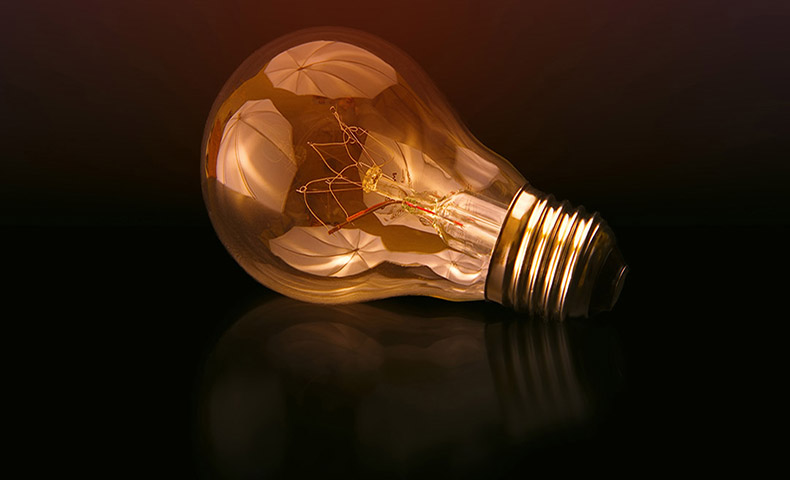
A platform hosting is needed to operate on Mars. The InSight lander is a solar bus (or “platform”) 1.5 m across and mounted on fitted legs with a suspension system designed to absorb shocks.
The role of this structure is to host several subsystems controlling crucial element such as power supply, radio communications, propulsion and thermal control. These are orchestrated by an onboard computer.

To gain the power required to its operation, InSight relies on a solar array attached to rechargeable batteries.
The cruise stage is fitted with two solar arrays giving a surface area of 3.2 m² and providing 957 watts when near the Terre, and 477 watts when it’s in closer range of Mars. In addition, the InSight lander has its own ultra-flexible circular solar arrays covering 4.2 m².
They are deployed approximately 20 minutes after landing, the time required for the dust raised by the retrorockets to settle again.On Mars, dust is the solar arrays’ number one enemy. Dust storms on the Red Planet make the atmosphere cloudy and eventually, reduce the arrays’ performance. Slowly, Martian dust settles on the arrays. The solar arrays are blown off occasionally by wind—a natural but random solution.
Though based on the Phoenix lander, InSight has one significant advantage. The two key scientific instruments — SEIS and HP3 — are on the ground, and the robotic arm used to place them there has been stowed away, the deck will be empty, offering a further surface for additional solar cells.
Due to problem, mission engineers added several auxiliary solar arrays covering a total surface area of 0.8 m². One of them replaced the Wind and Thermal Shield (WTS). This additional power allowing InSight to be untroubled by dark periods with little solar illumination, whether due to dust storms or the rigours of the Martian winter. The lander’s solar arrays can recharge the two 25 amp hour lithium batteries to power the spacecraft during darkness.
The SEIS seismometer will consume around 5 watt, depending on the measurement mode activated. During the winter, when the period of solar illumination is shorter and the solar arrays provide less power, SEIS will record fewer data.
On the other hand, at other times it will be switched to campaign mode to optimize seismic measurements, a mode mandating further power.

A.InSight Measures Quakes On Mars
Quakes on Earth are detected using networks of seismometers. InSight has only one, called SEIS (Seismic Experiment for Interior Structure). The science team applies unique measurements to analyze seismic waves real time anywhere on Mars.
SEIS calculates seismic waves from mars quakes and meteorite hits. The speed alters depending on the material traveling through. This aides scientists in discovering what the planet's interior is made of. Seismic waves come in different flavors. Some waves are colorful line the planet's surface, while others develop from its center and at several speeds. Seismologists uses each type as a tool to triangulate where and when a seismic event has occured.
This means InSight could landed anywhere on Mars without moving and continue to gathered the same type of information.
B.InSight's Seismometer Requires A Quiet Enviroment
Seismometers are sensitive and require isolation from "noise" to analyze seismic waves accurately.
SEIS can successfully detect even the slightest vibrations. It will be the first seismometer on the Martian surface, where it will much more accurate than seismometers that sat atop the Viking landers.
Engineers have given SEIS a shell that consists of a wind-and-thermal shield that InSight's arm will place over the seismometer. The dome presses down when wind blows over it; a Mylar-and-chainmail skirt keeps wind from blowing in. It shelters the SEIS from Mars' intense temperature swings, that could potentially alter minute changes in the instrument's springs and electronics.
C.InSight Has a Self-Hammering Nail
InSight carries a nail that also needs to be held steady. This quirky instrument, called HP3 (Heat Flow and Physical Properties Package) holds unto a spike attached to a long tether. A mechanism inside the spike hammers up to 16 feet underground, dragging out the tether that’s embedded with heat sensors. It senses heat inside Mars since the planet first formed. That heat molded its surface with volcanoes, mountains, valleys, and possibly even ancient rivers.
D.InSight Lands in the Safest Location Possible
Since InSight requires stillness so it can collect seismic and heat data, its free to land in the safest location possible.
InSight's team was safely perched on Mars' equator called Elysium Planitia. This spot makes it much easier and safer to land and has plenty of sunlight to power the spacecraft. Since it’s solar powered and has a lot of sunlight at Mars' equator means it can provides reliable and consistent data to evaluate.
E.InSight Can Measure Mars' Wobble
InSight has two X-band antennas on its deck that make up a third instrument, called RISE (Rotation and Interior Structure Experiment). Radio signals from RISE is analyzed to study the"wobble" in the plant’s rotation. It’s a sign of whether the planet’s core is liquid or solid. These lead are clues to the planet's thin magnetic field.
Collecting data on this wobble hasn't happened since Mars Pathfinder's three-month mission in the late 90’s. Every time a stationary spacecraft sends radio signals from Mars, it can improves their measurements.

NASA’s InSight spacecraft is closer to reaching Mars this month. It passed a vital test last January. It consisted of extending its solar array which is required to power the spacecraft for its stay on Mars.
The trial for NASA’s Interior Exploration applies Seismic Investigations, Geodesy and Heat Transport, also known as InSight. It was conducted at Lockheed Martin Space near Denver, Colorado. The team leading the mission at NASA’s Jet Propulsion Laboratory in Pasadena, California, have supervised at Lockheed Martian Space.
“This is the last time we will see the spacecraft in landed configuration before it arrives at the Red Planet,” says Scott Daniels, Lockheed Martin InSight Assembly, Test and Launch Operations (ATLO) manager. “There are still many steps we have to take before launch, but this is a critical milestone before shipping to Vandenberg Air Force Base in California.”
The solar panels appear like a fan maximize the weak sunlight Mars gets. Since Mars is further away from the Sun, it receives about half as much sunlight as Earth. Due to the sun’s strength and Mar’s thin atmosphere, the panels must be efficient. The solar panels need to power InSight for at least one Martian year, which is equivalent to two Earth years, which fulfill’s the mission’s main objectives. The primary mission will be to study the interior and the content’s underneath.
“Think of InSight as Mars’ first health checkup in more than 4.5 billion years,” says Bruce Banerdt of JPL, the mission’s main investigator. “We’ll study its pulse by ‘listening’ for marsquakes with a seismometer. We’ll take its temperature with a heat probe, and we’ll check its reflexes with a radio experiment.”
Engineers included a microchip with more than 1.6 million names of members of the public on the spacecraft. It’s glued to the top of InSight in 2015. This chip contains 827,000 names, bringing the grand total up to about 2.4 million names making the journey to Mars. “It’s a fun way for the public to feel personally invested in the mission,” Banerdt says. “We’re happy to have them along for the ride.”
The chips were inscribed at JPL’s Microdevices Laboratory who also developed lists of adding names and images to other spacecrafts. Each character is a minuscule 400 nanometres wide.

Solar power has been practical for spacecraft operating no farther from the Sun than the orbit of Jupiter. For instance, Juno, Magellan, Mars Global Surveyor, and Mars Observer used solar as does the Earth-orbiting, Hubble Space Telescope. The Rosetta space probe, launched 2 March 2004, used its 64 square meteres f solar as far as the orbit of Jupiter. The furthest use was the Stardust spacecraft. Solar power for propulsion was also used on the European lunar mission SMART-1 with a Hall effect thruster.
The Juno mission, launched in 2011, is the first mission to Jupiter to use solar panels instead of the traditional RTGs used by previous outer solar system missions, making it the furthest spacecraft to use solar panels to date. It has 72 square metres of panels. Another spacecraft of interest is Dawn which went into orbit around 4 Vesta in 2011. It used ion thrusters to get to Ceres.

The potential for solar powered spacecraft beyond Jupiter has been studied.
The International Space Station uses solar arrays to power the station. The 262,400 solar cells cover around 27,000 square feet of space. There are four sets of arrays that power the station and the fourth set of arrays were installed in March 2009. 84 to 120 kilowatts of electricity can be generated from the solar.
It’s best to decrease solar array mass, and to up the power produced per unit area. This will decrease overall spacecraft mass, and may make the operation of solar-powered spacecraft feasible at larger distances from the sun. Solar array mass is decreased with thin-film photovoltaic cells, flexible blanket substrates, and composite support structures. Solar array efficiency could be improved by using new photovoltaic cell materials and solar concentrators that intensify sunlight. Photovoltaic concentrator solar arrays for primary spacecraft power are devices which intensify the sunlight on the photovoltaics. This design uses a flat lens, called a Fresnel lens, which takes a large area of sunlight and concentrates it onto a smaller spot.
Gallium arsenide are solar cells favored over crystalline silicon due to higher efficiency and degrade slower than silicon in the radiation found in space. The most efficient solar cells in production are multi-junction photovoltaic cells. These use a combination of layers of gallium arsenide, indium gallium phosphide, and germanium to catch more energy from solar. Leading edge multi-junction cells are capable of exceeding 38.8% under non-concentrated AM1.5G illumination and 46% using concentrated AM1.5G illumination..
Solar concentrators put one of these lenses over every cell. This focuses light from the large concentrator area down to the smaller cell area. This permits the quantity of expensive cells to be decreased by the amount of concentration. Concentrators are ideal when there is a single source of light and the concentrator can be pointed right at it. This is best in space, where the Sun is a single light source. Solar cells are the most expensive part of solar arrays, and arrays are often a very expensive part of the spacecraft. This technology may allow costs to be cut significantly due to the utilization of less material.
For more information relating to going solar, don't forget to visit our solar blog section for more handy guides and articles.
HahaSmart Blog - More Solar Tips and Guide
HahaSmart News - Stay Informed
Your Solar Incentives - See Credits and Incentives in Your Area
Check Your Home's Solar Price - See How Much You Save
Register Now - Unlock The Lowest Solar Prices in Your Area


Input your address to see if it is solar friendly and how much you can save with solar.
Great. Your address is perfect for solar. Solar incentive is still available. Select monthly utility cost and calculate the size of solar system you will need now.
| kw System size | years Payback period | Lifetime savings |
No money down, 100% finance is available.
|
|
Looking to join a solar community? Sign up now and we will find them for you. |
Comments